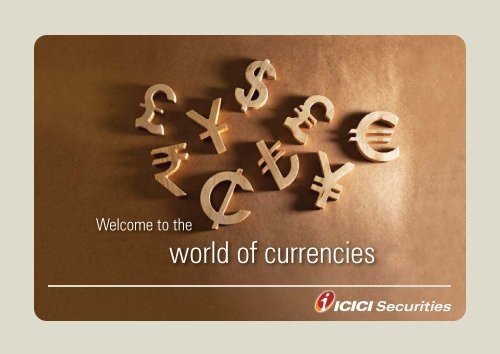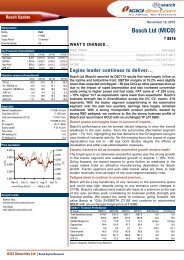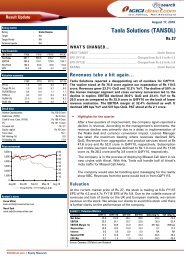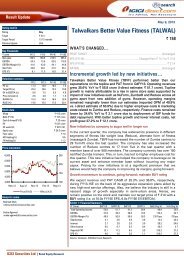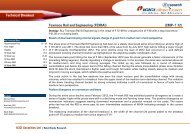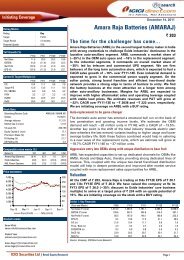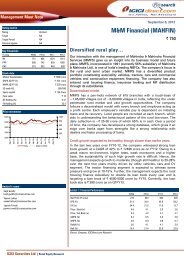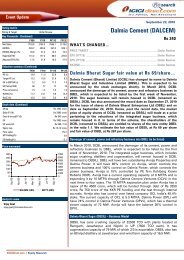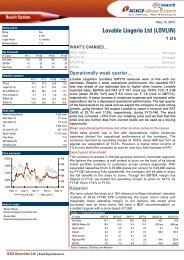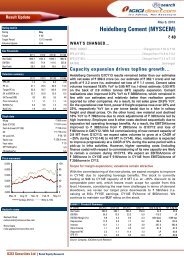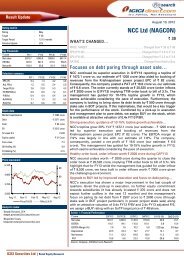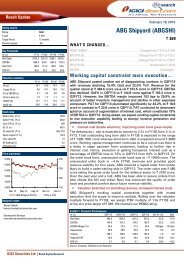View the Currency presentation - ICICI Direct
View the Currency presentation - ICICI Direct
View the Currency presentation - ICICI Direct
Create successful ePaper yourself
Turn your PDF publications into a flip-book with our unique Google optimized e-Paper software.
Welcome to <strong>the</strong><br />
world of currencies
What is a currency?<br />
• A generally acceptedmedium of exchange for goods and services, issued by a government<br />
and circulated within an economy.
World currencies<br />
• Different countries have different currencies.
What is currency exchange rate?<br />
• Each currency of a country is valued with o<strong>the</strong>r currency, <strong>the</strong> net ratio is called exchange rate.
<strong>Currency</strong> exchange rates<br />
• Each currency exchange rate represents a pair of currency.<br />
• Examples of currency pairs:<br />
USD/INR - US Dollar against Indian Rupee<br />
EUR/USD - Euro against US Dollar<br />
EUR/GBP - Euro against British Pound<br />
GBP/INR - British Pound against Indian Rupee
How is currency quoted?<br />
• Each currency is quoted/paired/valued with ano<strong>the</strong>r currency.<br />
USD/INR = 55.60<br />
Base currency<br />
Quote currency<br />
• Quote of USD/INR = 55.60 means for every 1 USD paid, INR 55.60 will be received.<br />
• Quote of EUR/USD = 1.2745 means for every 1 Euro paid, 1.2745 USD will be received.
Understanding appreciation & depreciation of currency<br />
$<br />
`<br />
• How valuation of rupee changes?
Valuation changes due to<br />
Economic forces - inflation<br />
rate, purchasing power,<br />
interest rate<br />
Market forces - supply &<br />
demand of dollar & rupee<br />
due to economic factors<br />
The value of a currency depends on demand and supply of currency.<br />
Demand depends on economic valuations & economic factors.
Economic forces affecting rupee…<br />
• Macro economic reviews<br />
• Monetary policy<br />
• Banking policies<br />
• Economic data announcements<br />
• Global economic scenario<br />
• Global capital flow<br />
• Performance of equity/financial markets<br />
• Performance of o<strong>the</strong>r currencies<br />
• Performance of key commodities affecting trade<br />
• Policy announcements affecting flows – trade or capital<br />
Do we have<br />
control on<br />
<strong>the</strong>se<br />
factors???
Impact of economic news on rupee…<br />
News flow Meaning Impact on rupee<br />
Greek crisis<br />
Euro crisis<br />
FII outflow<br />
Rise of OIL price<br />
Overseas loan payment<br />
RBI managing strong rupee<br />
FII/FDI inflow in India<br />
Overseas borrowing<br />
Higher bank rates<br />
News: GDP will improve<br />
NRI sending money<br />
Gold rises<br />
RBI managing rupee fall<br />
Outflow of Greek currency & investment in USD.<br />
USD demanded in market against Euro<br />
FII sell rupee & buy USD<br />
Higher inflation - Low purchasing power,<br />
& demand for more USD, fall of rupee value against USD<br />
Payment in USD against rupee. Corp sell rupee & buy USD<br />
Demands dollars & supply rupee<br />
Inflow by FDI/FII supply of USD & demand of rupee<br />
Demands for dollars by corporate against INR<br />
Investment by FII for bank interest<br />
Foreign investors will bring money to invest<br />
USD flow<br />
Buying gold against USD. Supply of USD.<br />
Demand for dollar against rupee. Outflow of dollar<br />
Depreciation<br />
Depreciation<br />
Depreciation<br />
Depreciation<br />
Depreciation<br />
Depreciation<br />
Appreciation<br />
Appreciation<br />
Appreciation<br />
Appreciation<br />
Appreciation<br />
Appreciation<br />
Appreciation
How is change in currency rate a financial risk?
USD-INR in last 4 years
USD-INR movement impact…<br />
Do we know<br />
what will be<br />
USD-INR rate<br />
next???
What is currency risk?<br />
When rise or fall in value of one currency against ano<strong>the</strong>r currency has direct<br />
or indirect impact on financial statements, it is a currency risk.
When is currency a risk?<br />
• <strong>Currency</strong> risk occurs when<br />
- transactions undertaken by entity involves international currencies.<br />
- rate of exchange has direct or indirect impact on its financial statements.<br />
• Transactions may be<br />
- receivable or payable fx instruments.<br />
- purchase/sale commitments in fx.<br />
- future transactions in a foreign currency.<br />
- speculative transactions.
Who is affected by currency market?<br />
Corporate, exporters,<br />
importers, governments,<br />
central & o<strong>the</strong>r banks,<br />
financial markets, individuals<br />
- travellers, students
How is exchange rate a financial risk?<br />
• Mr. ABC is an exporter and has to receive USD 5 million as payment for his exported<br />
goods next month. If today USD-INR rate is 55.60, Mr. ABC is expecting to receive<br />
INR 27.8 Crs. (5*10^6*55.60 = 27.8 Cr).<br />
• By <strong>the</strong> time of payment delivery, if USD-INR moves to 57.30, Mr. ABC will receive<br />
INR 28.65 Cr. He will gain additional INR 0.85 Cr.<br />
• In a situation, USD-INR changes to 53.50 at <strong>the</strong> time of delivery, Mr. ABC will receive<br />
INR 26.75 Cr. A loss of INR 1.05 Cr.<br />
• In above situations, Mr. ABC will hugely gain or lose basis exchange rate<br />
movement in USD-INR, for which he has no control.
How is currency a risk – more examples...<br />
• Mr. XYZ imports goods. He is expecting delivery of his contract next month and has to<br />
pay USD 10 million at <strong>the</strong> time of goods delivered.<br />
• If today USD-INR rate is 55.60, XYZ has to pay INR 55.60 Cr. (10*10^6*55.60 = 55.6 Cr).<br />
• By <strong>the</strong> time of payment, if USD-INR moves to 57.30, Mr. XYZ will have to pay INR 57.30<br />
Cr. He will have to pay additional INR 1.70 Cr.<br />
• In a situation, USD-INR changes to 53.50 at <strong>the</strong> time of delivery, Mr. XYZ will have to pay<br />
INR 53.50 Cr. A gain of INR 2.10 Cr.<br />
• In above situations, Mr. XYZ will gain or lose basis exchange rate movement in<br />
USD-INR, for which he has no control.
Some more situations -<br />
• Anjali Jewellers is importing 100 KG of Gold, worth INR 30 Cr from US.<br />
• Ruchi Soya has entered in a contract to export Soya Oil to US worth INR 20,000 Cr next year.<br />
• Indian importer ABC partners has deposited USD 5 Million as refundable guarantee deposit<br />
to tie up with US Company for 5 Years.<br />
• Same ABC partners is sourcing business from US every month worth INR 25 Cr every year.<br />
• Indo-Call runs 1000-seat BPO in India and US. Receives $100 per day as servicing fee.<br />
• What happens if <strong>the</strong> INR depreciates against USD - rate moves from $50 to &52 in a month
And <strong>the</strong> fx risks -<br />
• Anjali Jewellers’ operating profit falls with Rs 1.2 Cr every month.<br />
• Ruchi Soya’s net income rises by 800 Cr a year.<br />
• ABC partners will receive INR 10 Million extra on conversion of his deposit.<br />
• Same ABC partners’ profit for <strong>the</strong> year increases to 1Cr for <strong>the</strong> year.<br />
• Indo-Call receives Rs 60 Lakh additional gain each month.
Problem - currency exposure risk solution - hedging
Problem -<br />
• Firms involved in international transactions face a risk, an unknown gain/loss,<br />
on account of unanticipated changes in exchange rates.<br />
• These transactions are quantified in terms of ‘international exposure’.<br />
• Un-hedged exposures adversely affects P&L of companies and creates<br />
operational hitches like cash flow requirements etc.
We need to manage our fx exposure<br />
Payables<br />
Receivables<br />
Imports<br />
Exports<br />
Capital good<br />
imports<br />
Overseas borrowings -<br />
FCCBs, ECBs<br />
Foreign deposits<br />
Engineering<br />
offshore contracts<br />
Capital flows -<br />
FDI, FI<br />
Service export<br />
contracts
Solution on fx risk - hedging<br />
• Hedging is a position established in one market in an attempt to offset<br />
exposure in some opposite position in ano<strong>the</strong>r market.<br />
• The goal is to minimize one's exposure to unwanted risk.<br />
• Hedging is thus taking of a position, ei<strong>the</strong>r acquiring a cash flow or an asset<br />
or a contract(including a forward contract) that will rise(fall) in value to<br />
offset a fall(rise) in value of an existing position.
What is hedging – overview & concept?<br />
• Hedging is a position established in one market in an attempt to offset<br />
exposure in some opposite position in ano<strong>the</strong>r market.<br />
• The goal is to minimize one's exposure to unwanted risk.<br />
• Hedging is thus taking of a position, ei<strong>the</strong>r acquiring a cash flow or an asset<br />
or a contract(including a forward contract) that will rise(fall) in value to<br />
offset a fall(rise) in value of an existing position.
Keeping it simple - how to hedge?<br />
Forex receivable<br />
• Short/Sell futures<br />
Forex payable<br />
• Long/Buy futures
Cost of hedging & management of hedge<br />
• Set price for transacting a foreign currency in <strong>the</strong> future<br />
• Hedge forex exposure<br />
• Cost to “lock in” this exchange rate<br />
- margin deposits<br />
- premium related to future rate for currency<br />
- brokerage fee to obtain contract<br />
- mark to market cash flow<br />
- net settlement cash flow
Problem - currency <strong>Currency</strong> exposure Exposure risk Risk<br />
Solution - hedging Hedging<br />
Best Tool - currency <strong>Currency</strong> derivatives Derivatives
What are currency derivatives?<br />
• The term 'Derivatives' indicates it derives its value from some underlying i.e. it has<br />
no independent value. Underlying can be securities, stock market index,<br />
commodities, bullion, currency etc.<br />
• <strong>Currency</strong> derivatives implies contracts where underlying would be <strong>the</strong> currency<br />
exchange rate.<br />
• Examples of currency trading pairs:<br />
- USD-INR – US Dollar against Indian Rupee<br />
- USD-EUR – US Dollar against Euro<br />
- EUR-GBP – Euro against British Pound
<strong>Currency</strong> Derivatives @ <strong>ICICI</strong>direct.com
<strong>Currency</strong> trading @ <strong>ICICI</strong>direct.com<br />
• Products offered<br />
- 4 currency pairs<br />
• USD-INR – 6 month forward contracts available for trading<br />
• GBP-INR – 3 month forward contracts available for trading<br />
• EUR-INR - 3 month forward contracts available for trading<br />
• JPY-INR – 2 month forward contracts available for trading<br />
- Only futures<br />
- Option trading not available<br />
• Trading screens<br />
- Online through web-trading<br />
- Call n trade facility
<strong>Currency</strong> Trading @ <strong>ICICI</strong>direct.com<br />
Symbol USD/INR EUR/INR GBP/INR JPY/INR<br />
Instrument Type<br />
Units of Trading<br />
Underlying<br />
Tick Size<br />
Trading Hours<br />
Contract Trading Cycle<br />
Last trading Cycle<br />
FUTCUR<br />
1 unit denotes<br />
1000 Dollar<br />
The Exchange rate<br />
in INR for US Dollars<br />
0.25 paise or<br />
INR 0.0025<br />
RBI reference rate<br />
on last trading day<br />
FUTCUR FUTCUR FUTCUR<br />
1 unit denotes<br />
1000 Eur<br />
The Exchange rate in<br />
INR for Euro<br />
0.25 paise or<br />
INR 0.0025<br />
RBI reference rate<br />
on last trading day<br />
1 unit denotes<br />
1000 GBP<br />
The Exchange rate in<br />
INR for Pound Sterling<br />
0.25 paise or<br />
INR 0.0025<br />
RBI reference rate<br />
on last trading day<br />
1 unit denotes<br />
1000 Yen<br />
The Exchange rate in<br />
INR for Japanese Yen<br />
0.25 paise or<br />
INR 0.0025 (The Quote<br />
will be for 100 JPY)<br />
9.00 am to 5.00 p.m. ( Monday - Friday )<br />
12 months Trading Cycle<br />
Two working days prior to <strong>the</strong> last business day of <strong>the</strong> expiry month at 12.15 pm<br />
Last working day ( excluding Saturdays ) of <strong>the</strong> expiry month. The last working day will b e <strong>the</strong><br />
Final Settlement Day same as that for interbank Settlements in Mumbai<br />
Daily Settlement : T+ 1<br />
Final Settlement : T + 2<br />
Mode of Settlement Cash Settled in INR<br />
Daily Settlement price (DSP)<br />
Calculated on <strong>the</strong> basis of <strong>the</strong> last half an hou weighted average price<br />
Final Settlement Price<br />
RBI reference rate<br />
on last trading day
Margin calculation in currency futures<br />
Pair Underlying Contract example<br />
Qty Lot size LTP<br />
Contract<br />
value<br />
Margin<br />
per lot<br />
Margin<br />
%<br />
USD-INR<br />
USD<br />
against INR<br />
FUT-USD-INR-<br />
28-08-2013<br />
1<br />
1000<br />
62.7425 62742.5 5333 8.5%<br />
EUR-INR<br />
EUR<br />
against INR<br />
FUT-EUR-INR-<br />
28-08-2013<br />
1<br />
1000<br />
83.6325 83632.5 3764 4.5%<br />
GBP-INR<br />
GBP<br />
against INR<br />
FUT-GBP-INR-<br />
28-08-2013<br />
1<br />
1000<br />
98.0925 98092.5 4904 5%<br />
JPY-INR<br />
JPY<br />
against INR<br />
FUT-JPY-INR<br />
28-08-2013<br />
1<br />
1000<br />
64.6925 64692.5 3882 6%
Equity<br />
<strong>Currency</strong><br />
Derivatives
Equity derivates vs currency derivatives<br />
Underlying<br />
• Market indices like nifty, bank nifty<br />
• Equity scrips<br />
• <strong>Currency</strong> pair is used as indices like<br />
USD-INR, EUR-INR
Equity derivates vs currency derivatives<br />
Margins<br />
• Vary from 11% to 35%, and upto<br />
60% in exception.<br />
• Low margins in indices – starting<br />
from 11%.<br />
• Prime stock margins vary<br />
from 16% to 25%.<br />
• General stocks margins start from<br />
25% and above.<br />
• 1 contract of nifty worth,<br />
Rs 2,45,000/- available at margin of<br />
Rs 26950. (@4900).<br />
• Margins very low.<br />
• Vary from 8.5% for USD INR.<br />
• Exceptional margin applicable and<br />
extended to 1 - 2%.<br />
• 1 Lot position of USD-INR available<br />
at Rs 5200/-.<br />
• For contracts, equivalent to nifty -<br />
Rs 2,45,000/-, only Rs 20825/- is<br />
required.
Equity derivates vs currency derivatives<br />
Lot size<br />
• Lot size is based on contract value.<br />
• Standard value set by NSE is<br />
Rs 2.5 Lakhs.<br />
• Number of units in lot vary as per<br />
market price of scrip at <strong>the</strong> time<br />
of initiating <strong>the</strong> contract by NSE.<br />
• Lot size is based on number of units<br />
of underlying in contract.<br />
• Standard is 1000 Units of currency.<br />
• Lot value is not <strong>the</strong> set standard.
Equity derivates vs currency derivatives<br />
Tick size<br />
• Tick size of Eq Dv is Rs 0.05 i.e. 5 Paise.<br />
• Example of bid & offer<br />
Eq Dv<br />
Best bid price Best offer price<br />
55.95 56.00<br />
55.90 56.05<br />
55.85 56.10<br />
55.80 56.15<br />
• Fx Dv tick size is Rs 0.0025 or 1/4th<br />
of 1Paise or 0.0025 Paise.<br />
• Example of bid & offer<br />
Best bid price<br />
Fx Dv<br />
Best offer price<br />
55.9875 55.9900<br />
55.9850 55.9925<br />
55.9825 55.9950<br />
55.9800 55.9975<br />
55.9775 56.0000
Equity derivates Vs currency derivatives<br />
Exposure with Rs 1 Lakh fund<br />
• 3 nifty contracts can be taken as<br />
position(avg margin 11%).<br />
• 3 lots of nifty stocks<br />
(avg margin 14-15%).<br />
• 2 lots of junior nifty stocks.<br />
• 1 lot of fair margin stock.<br />
• FX Dv is low margin & high<br />
leverage product.<br />
• You can take position of 20 lots<br />
of USD-INR.<br />
• You can take position of 26 lots<br />
of EUR-INR.<br />
• Position value is worth<br />
Rs 12 lakhs.
Equity derivates vs currency derivatives<br />
Instrument<br />
Funds<br />
available<br />
Contract<br />
size<br />
Price<br />
Contract<br />
value<br />
Margin<br />
on<br />
contract<br />
Margin<br />
value<br />
No. of<br />
contracts<br />
on full<br />
margin<br />
Position<br />
value in<br />
lakhs<br />
Nifty 100000 50 4900 245000 11% 26950 3 7.35<br />
ITC 100000 1000 233 233000 14% 32620 3 6.99<br />
PFC 100000 2000 150 300000 19% 57000 2 3.00<br />
USD INR 100000 1000 62.75 62750 9% 5333.75 19 11.76<br />
EUR INR 100000 1000 83.68 83680 4.5% 3765.6 27 22.22<br />
• In Eq dv, Rs 1 Lakh can allow 3 Lots of nifty and total position value will be Rs 7.35 Lakhs<br />
(assuming nifty price at 4900 and 11% margin).<br />
• In FX, Rs 1 Lakh can allow 19 lots of USD-INR and total position value will be Rs 11.76 Lakhs<br />
(assuming USD-INR pair at Rs 62 with 8.5% margin).<br />
• <strong>Currency</strong> derivatives consumes lower margin & provides 3 times higher exposure than equity derivatives.
Daily currency report, provided by <strong>ICICI</strong> Securities research
Monthly <strong>Currency</strong> Derivatives Research Report
Disclaimer<br />
<strong>ICICI</strong> Securities Ltd.( I-Sec). Registered office of I-Sec is at <strong>ICICI</strong> Securities Ltd. - <strong>ICICI</strong> Centre, H. T. Parekh Marg, Churchgate, Mumbai - 400020, India, Tel No : 022 - 2288 2460, 022 - 2288<br />
2470. I-Sec is a Member of National Stock Exchange of India Ltd., SEBI Regn. No. INB 230773037 (CM), SEBI Regn. No. INF 230773037 (F&O), SEBI Regn No. INE230773037 (CD), Bombay<br />
Stock Exchange Ltd., SEBI Regn. No. INB011286854 (CM), SEBI Regn No. INF010773035 (F&O). Name of <strong>the</strong> Compliance officer: Ms. Mamta Jayaram Shetty, Contact number:<br />
022-40701000, E-mail address: complianceofficer@icicisecurities.com. Kindly read <strong>the</strong> Risk Disclosure Documents carefully before investing in Equity Shares, Derivatives or o<strong>the</strong>r<br />
instruments traded on <strong>the</strong> Stock Exchanges. The contents herein above shall not be considered as an invitation or persuasion to trade or invest. Investors should make independent<br />
judgment with regard suitability, profitability, and fitness of any product or service offered herein above. I-Sec and affiliates accept no liabilities for any loss or damage of any kind<br />
arising out of any actions taken in reliance <strong>the</strong>reon.The contents of this <strong>presentation</strong> are solely for informational purpose and may not be used or considered as an offer document<br />
or solicitation of offer to buy or sell or subscribe for securities or o<strong>the</strong>r financial instruments or any o<strong>the</strong>r product. While due care has been taken in preparing this <strong>presentation</strong>, I-Sec<br />
and affiliates accept no liabilities for any loss or damage of any kind arising out of any inaccurate, delayed or incomplete information nor for any actions taken in reliance <strong>the</strong>reon.
Thank You


